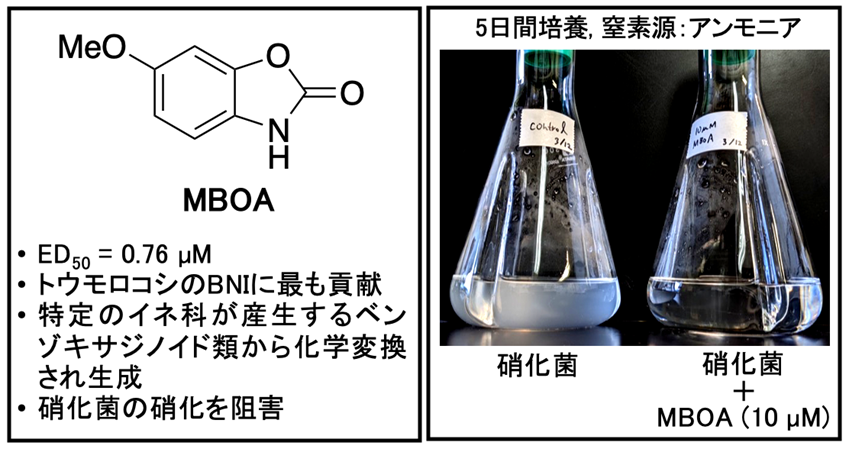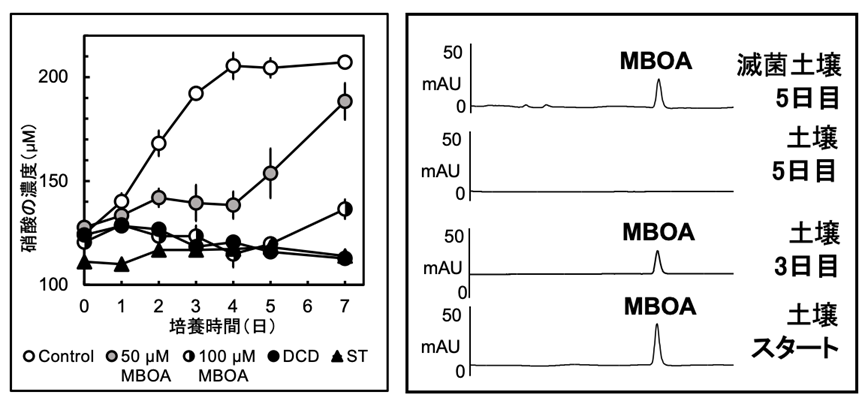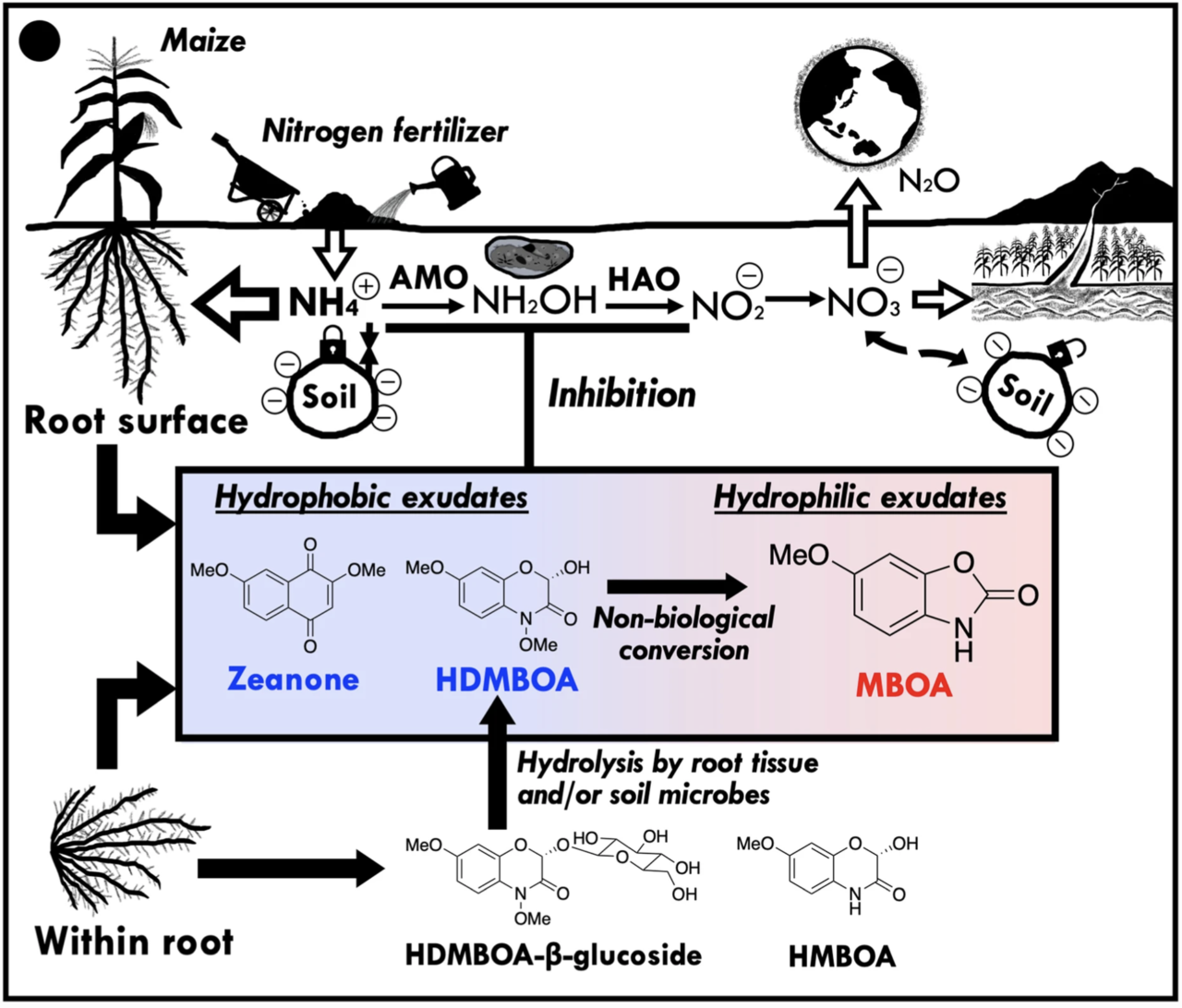研究成果
Successful Identification of Key Compound for Biological Nitrification Inhibition in Maize
―Progress in developing BNI-enabled maize to reduce the use of nitrogen fertilizer―
Successful Identification of Key Compound for Biological Nitrification Inhibition in Maize
―Progress in developing BNI-enabled maize to reduce the use of nitrogen fertilizer―
|
Key Points
|
Overview
JIRCAS, in collaboration with the National Agriculture and Food Research Organization (NARO), has succeeded in identifying MBOA (6-methoxy-2(3H)-benzoxazolone), a water-soluble compound produced by maize roots that is the key to biological nitrification inhibition (BNI).
In modern agriculture, industrially produced ammonia nitrogen fertilizers are applied to farmland in large quantities and are converted by soil microorganisms (nitrifying bacteria) through nitrification to nitrate nitrogen, causing various problems such as water pollution and greenhouse gas emissions.
MBOA is known to be a secondary metabolite produced by certain grass species (maize and wheat). Incubation experiments and chemical analyses with soil and root exudates showed that MBOA inhibits nitrification and the growth of nitrifying bacteria. Furthermore, it was also found that HDMBOA, a hydrophobic BNI compound, is chemically converted into MBOA with more stable and potent BNI activity in soil and exhibits BNI.
Using MBOA, an important indicator of BNI expression, to enhance the BNI capacity of maize, the world's most widely produced field crop (1.03 billion tons produced, compared with 0.74 billion tons for wheat), will reduce nitrogen fertilizer runoff and environmental pollution, thereby improving the global nitrogen cycle. With the knowledge collected from this research, we will promote the development of a sustainable maize production system with reduced environmental impact through the development of "BNI-enabled maize" suitable for actual use in the agricultural system. In this way, we will increase the productivity and sustainability of agriculture and contribute to the promotion of the Sustainable Food Systems Strategy “MIDORI”.
The results of this research were published in the online edition of the international scientific journal Plant and Soil on April 25, 2023 (JST).
Funding
- This work was supported by the research project of JIRCAS entitled “Development of ecologically sustainable agricultural systems through practical use of the BNI function”.
Publication
- Authors
- J Otaka, GV Subbarao, ML Jiang, H Ono, T Yoshihashi
- Title
- Isolation and characterization of the hydrophilic BNI compound, 6-methoxy-2(3H)-benzoxazolone (MBOA), from Maize Roots
- Journal
- Plant and Soil
DOI : https://doi.org/10.1007/s11104-023-06021-7
For Inquiries
JIRCAS President KOYAMA Osamu
- Program Director:
- HAYASHI Keiichi (Environment Program)
- Principal Investigators:
- OTAKA Junnosuke (Biological Resources and Post-harvest Division)
YOSHIHASHI Tadashi (Biological Resources and Post-harvest Division)
Guntur SUBBARAO (Crop, Livestock and Environment Division) - Press Coordinator:
- OMORI Keisuke (Head, Information and Public Relations Office)
Press e-mail:koho-jircas@ml.affrc.go.jp
NARO
- Principal Investigator:
- ONO Hiroshi (Research Center for Advanced Analysis, Core Technology Research Headquarters)
- Press Coordinator:
- SUGIYAMA Noriaki (Research Promotion Office, Core Technology Research Headquarters)
Press e-mail:www_kiban@ml.affrc.go.jp
Reference Information
Fig. 2. Structure and characteristics of MBOA identified from maize root exudates and its effect on the growth of nitrifying bacteria
MBOA, identified as a BNI substance from the hydrophilic fraction of maize root exudates, is a natural substance produced by certain grass species such as wheat and rye , as well as maize (left panel). Liquid medium clouded white by proliferating bacteria and liquid medium remaining clear after strong growth inhibition in the presence of MBOA (right panel).
Fig. 3. MBOA's ability to inhibit nitrification and stability in soil incubation test
Soil was incubated in the presence of MBOA, and nitrate ion concentration (left) and MBOA concentration (right) were measured over time. The left panel shows that MBOA inhibited nitrification for 4 days, but its ability to inhibit nitrification decreased after the 5th day of incubation (gray circles (50 µM MBOA) and black and white circles (100 µM MBOA) in the left panel). In ST, the soil culture was sterilized by high-pressure steam and no nitrification occurred (▲ in the left figure). In parallel, MBOA concentration in the soil culture medium was analyzed by HPLC (right figure). The peak value indicating the presence of MBOA decreased with the incubation period (start → day 3 → day 5) in the unsterilized soil, but no decrease was observed in the sterilized soil (top right panel). These results indicate that MBOA inhibits soil-derived nitrification and that its activity weakens as MBOA is degraded by soil microorganisms.






